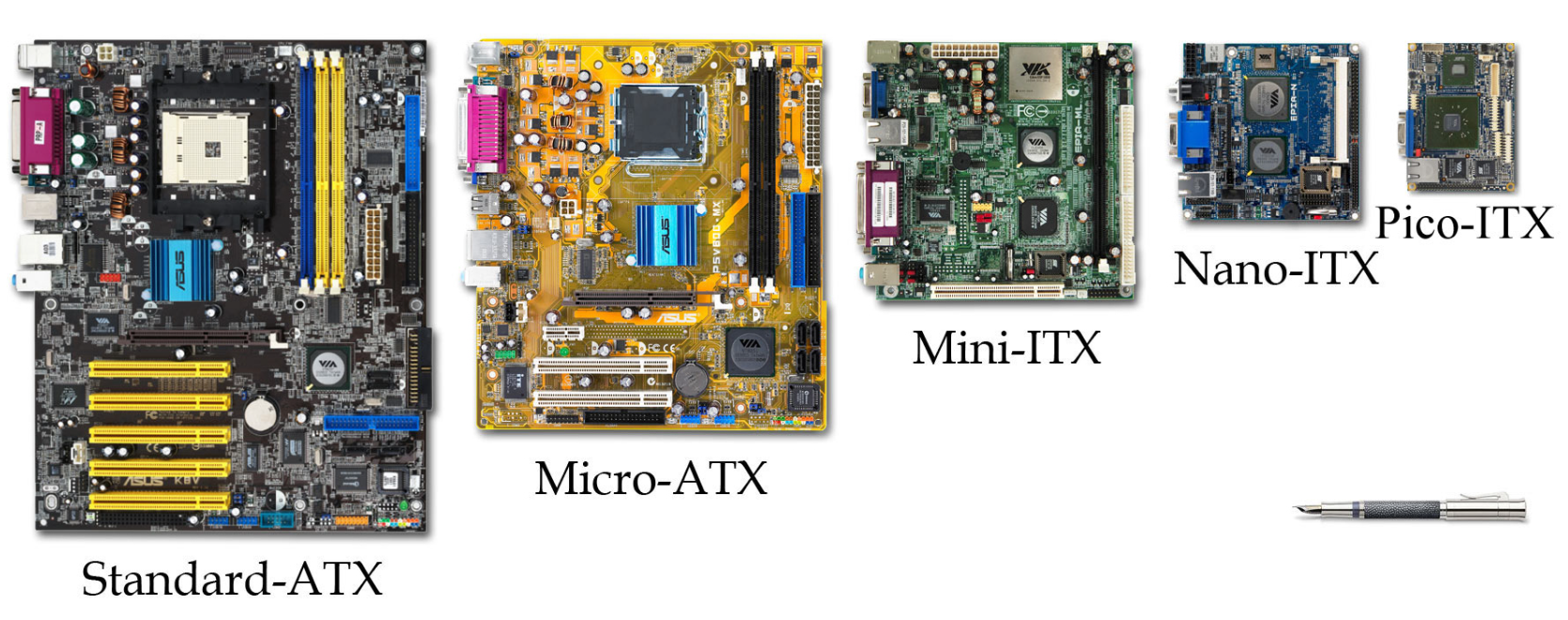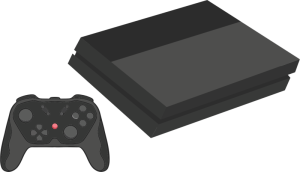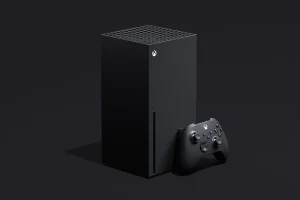The fundamental piece within all of our computers is the motherboard.
A personal computer motherboard is the main circuit board within a desktop PC, laptop or server.
The motherboard was first introduced to the world by IBM in 1981 and was named the “planar”
The board brought together all the ports and slots for various components for the first time.
it serves as a central hub for all the other modular parts like the CPU, RAM, hard drives. Think of it as the backbone that supports the rest of the components. It allows communication with every component such as CPU, RAM, GPU, Memory and more. It allows the computer setup to be modular and interchangeable, so if one component goes bad or you need to upgrade, this makes it possible to do so.
Depending on what sort of pc build you are going for, its important to select the right motherboard for the case that you want, the CPU and GPU you want, and consider size constraints as well and making sure your motherboard will work with the components that you want.
Especially when building a custom gaming build with the myriad of choices can be daunting. picking the right motherboard can limit your future upgrades or even bottleneck your build (limit to what it can do)
Take into account how many upgrade you will be making in the future. Do you want a future proof PC that will handle the upgrades you want in 5-10 years? Do you want a PC that will run the latest games for now, and build a whole new one later. All very important things to think about when building a pc starting with the motherboard.
in this article we will be going in depth to looks at the options available, as well as the differences between them so we can help you make informed decisions tailored to your computing needs.
Motherboards may vary in size, but one thing that doesn’t change much is the power connector. These power connectors are standardized. This allows you to have compatibility though different systems.
The motherboard often referred to by many names in tech circles as mobo, system board, mb, mainboard, planar board, logic board, main circuit board.
Motherboards are differentiated by a form factor known as Advanced Technology eXtended (ATX)
and this form factor is the industry standard and was invented at Intel. ATX is a motherboard and power supply configuration specification. The form factor is essential when building a new PC or upgrading an existing one.
ATX is the most common motherboard shape. others sizes are (microATX, flexATX, nano-ITX, mini-ITX) and more. According to wikipedia, there are more then 40 different sizes and types of motherboards.
lets analyze the different sizes available in main stream desktop computer segment. The important thing to consider is how much room and what features you need for this motherboard.
ATX vs ITX
Advanced Technology eXtended (ATX) – ATX boards are the de facto standard for desktop computer motherboards. This is the board you will find in most desktop computers. You may find a power connector 20 – 24 pins in size, providing additional power to the CPU if needed. The advantage ATX has is the cooling features. Because of the larger size of the board, you can place fan, and water coolers on the board.
Information Technology eXtended (ITX) – Simply a smaller version board mostly used for IT applications, are popular nowadays for building small, energy efficient computers. You can install one of these boards in a bigger case that was designed for a ATX board if you wanted to. This kind of board size is perfect if you want to build a home media center, or a workstation in a space with less room.
If you are looking for a custom gaming build, you want to get a ATX board. ATX boards allow you to place larger graphics cards and cooling systems to run intensive gaming, video editing etc.
Intel vs. AMD
When building a PC or upgrading an existing one, the choice between Intel and AMD is fundamental. This can impact compatibility, performance, and future upgrades. if you take a look at a Intel or AMD CPU, you will see lots of pins or contact points. These must match up with your board, or else it will not work. The fact is, intel is not compatible with AMD and vise versa,
For Intel, you will need LGA (Land Grid Array)
For AMD, you will need Socket AM4
Here’s a look at the differences between Intel and AMD.
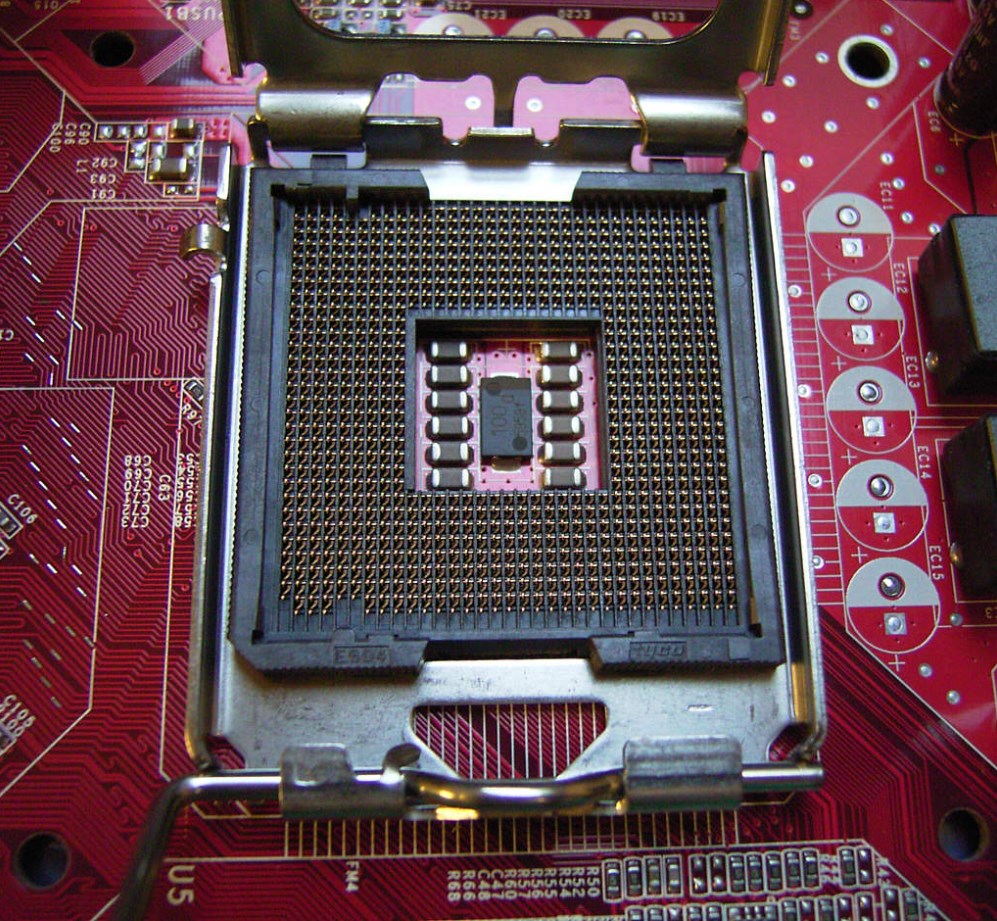
By User Smial
Intel: LGA sockets,
LGA 1200 (Intel 10th, 11th gen)
- Chipsets: z490, b460, h410
- Features: Supports up to PCIe 3.0, dual-channel DDR4 memory, integrated Intel UHD Graphics on most processors. High-end Z490 chipset supports overclocking.
LGA 1700 (Intel 12th and 13th Gen)
- Chipsets: Z690, B660, H610
- Features: Introduces support for PCIe 5.0 and DDR5 memory (though some motherboards also support DDR4), improved power efficiency and performance scaling, enhanced integrated graphics. Z690 chipset offers extensive overclocking and connectivity options.
LGA 2066 (Intel X-Series Processors)
- Chipsets: x299
- Features: Supports quad-channel DDR4 memory, numerous PCIe lanes, and is typically used for high-end desktops (HEDT) with a focus on extreme performance, content creation, and intensive multitasking.
AMD
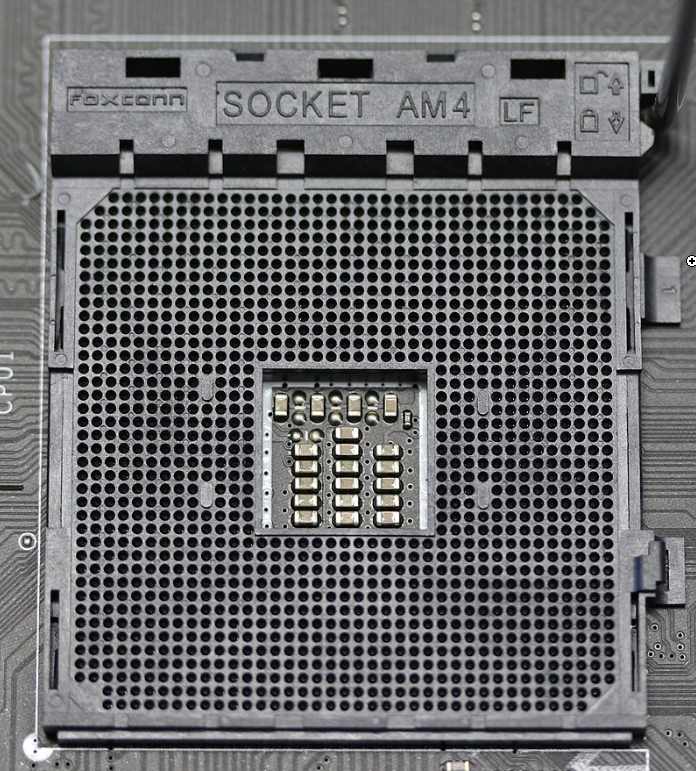
By Michael Wolf, Penig, CC BY-SA 3.0
AMD tends to maintain socket compatibility across multiple generations, which has been advantageous for users looking to upgrade their CPUs without replacing their motherboards. AMD are only compatible with AM4 sockets on motherboards.
AM4 (AMD Ryzen 1000 to 5000 Series)
- Chipsets: X570, B550, X470, B450
- Features: Supports PCIe 4.0 (X570 and B550), dual-channel DDR4 memory, extensive CPU and memory overclocking capabilities.
sTRX4 (AMD Ryzen Threadripper 3000 Series)
- Chipsets: TRX40
- Features: Supports quad-channel DDR4 memory, up to 64 PCIe 4.0 lanes, and massive multi-threaded performance. This platform is designed for professional content creators, developers, and enthusiasts who demand the best in compute power.
Both Intel and AMD offer competitive performance across various price points. Intel CPUs generally have higher clock speeds and better single-threaded performance, which is beneficial for gaming. AMD, however, often provides better multi-threaded performance at similar price points, making their processors excellent for multitasking and content creation.
AMD typically offers better backward and forward compatibility with its sockets, meaning that an AMD motherboard might support several generations of CPUs. Intel, however, frequently changes its socket or requires a new chipset, potentially necessitating a new motherboard with each major CPU upgrade.
AMD CPUs and motherboards often provide better price-to-performance ratios, especially in the mid-range and budget segments. Intel, while sometimes more expensive, offers premium performance, particularly in the high-end market.
The choice between Intel and AMD largely depends on specific needs such as performance requirements, budget constraints, and future-proofing considerations. AMD offers great versatility and value across many levels, with excellent upgrade paths. Intel, on the other hand, provides cutting-edge performance with its latest sockets and chipsets, especially in the realm of gaming and single-threaded applications. Understanding the specifics of each socket and chipset can help you make a more informed decision tailored to your computing needs.
Lets analyze the different sizes available.
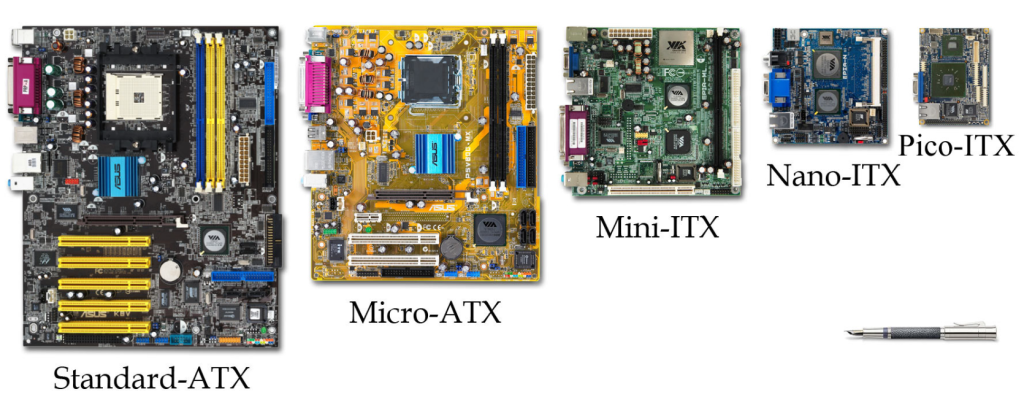
By VIA Gallery from Hsintien, Taiwan – VIA Mini-ITX Form Factor Comparison
- Standard-ATX
- Micro-ATX
- Mini-ITX
- Nano-TX
- Pico-ITX
Standard-ATX
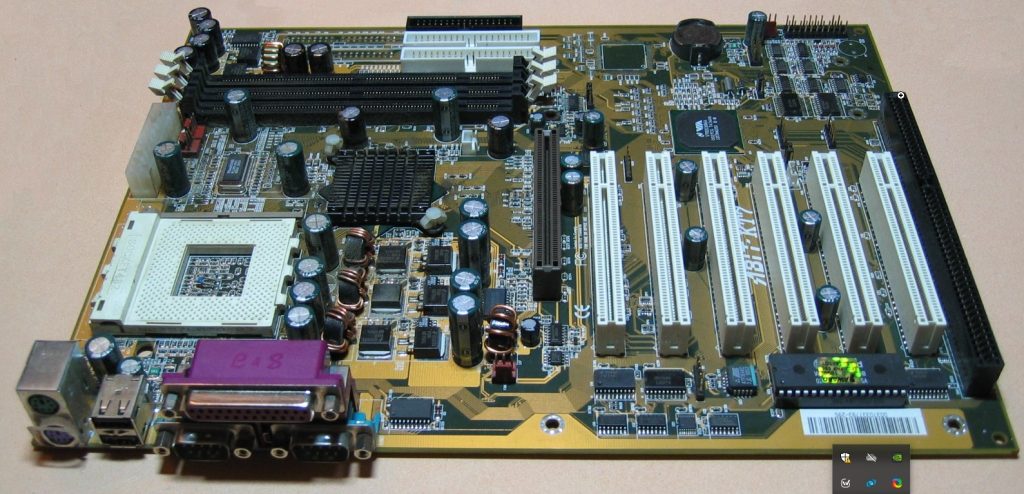
By Gary Houston
Standard-ATX offers plenty of room for customization. You have many options for expansion with the four RAM slots and seven expansion slots. If you want to install a hefty GPU or high end storage, ATX is perfect for that.
- Standard ATX measures to be 12 inches with the width varying from 6.7 to 9.6 inches (305 × 244 mm) some companies extend that to 10 × 12 in.
- Maximum number of expansion slots are 7
- Up to 10 mounting holes, although four of them are optional. (optional ones are circled in red)
- Input / Output Panel (I/O Panel)
Micro-ATX
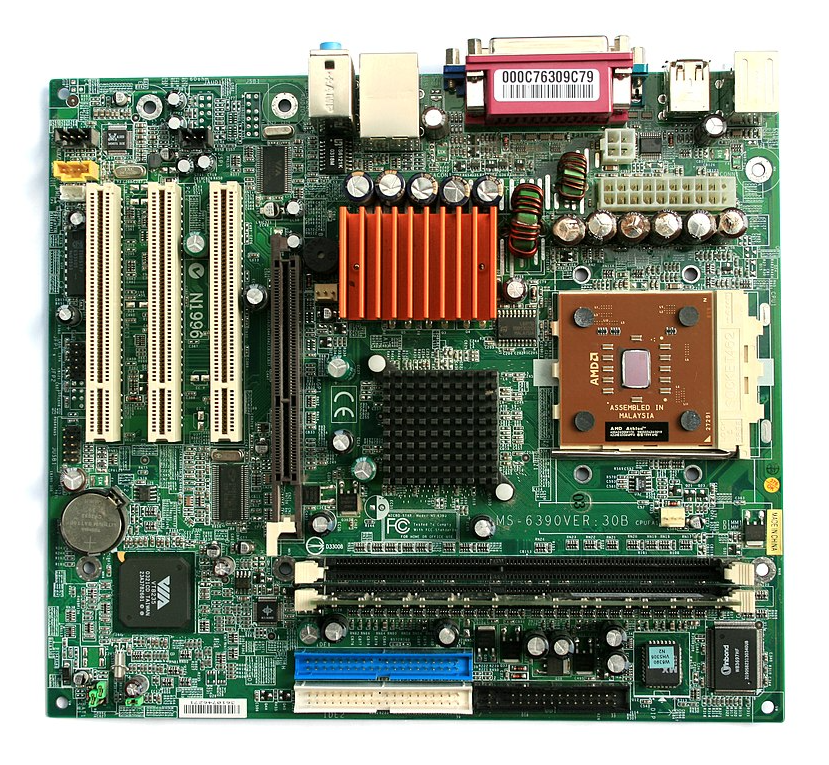
Photo by Jonathan Zander
This board is perfect for mid-range to budget PC’s, ideally for work use and light gaming. You have less PCI/PCI express slots, compared to the Standard ATX, but it still provides bang for your buck with a good CPU and GPU. Many brands offer integrated graphics which are perfect for a media center or light workstation.
- MicroATX measures at 9.6 in x 9.6. (244 x 244 mm)
Also known as μATX, uATX, and mATX
max number of expansion slots are 4 - up to 8 mounting holes, but the number depends on the size of the board. (necessary ones are circled in green, optional ones are circled in red)
Mini-ITX
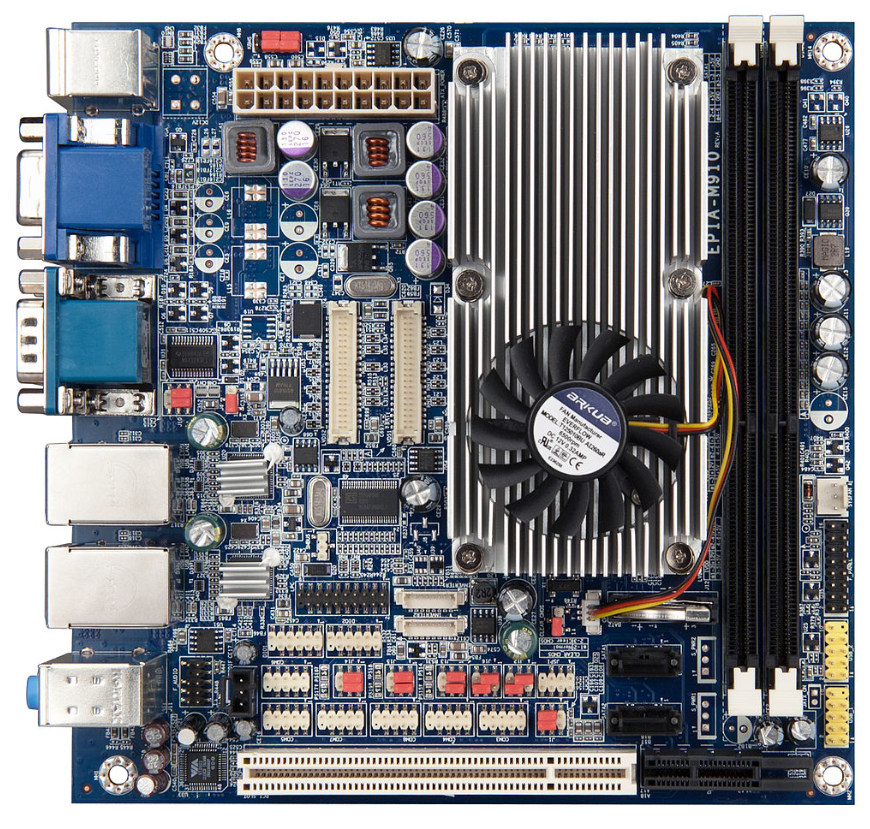
By VIA Gallery
developed by VIA technologies in 2001, mini-ITX motherboards usually are found in small form factor computers, such as a mini workstation, or even for something like a home theater PC. these are great for fan-less cooling, as a matter of fact they were designed for that. So if you want a silent PC, this may be there motherboard size you want.
- Mini-ITX measures at 6.7in x 6.7 (170 mm × 170 mm)
- 1 expansion slot.
- 4 mounting holes.
- be used in cases designed for ATX, micro-ATX and other ATX variants
Nano-ITX
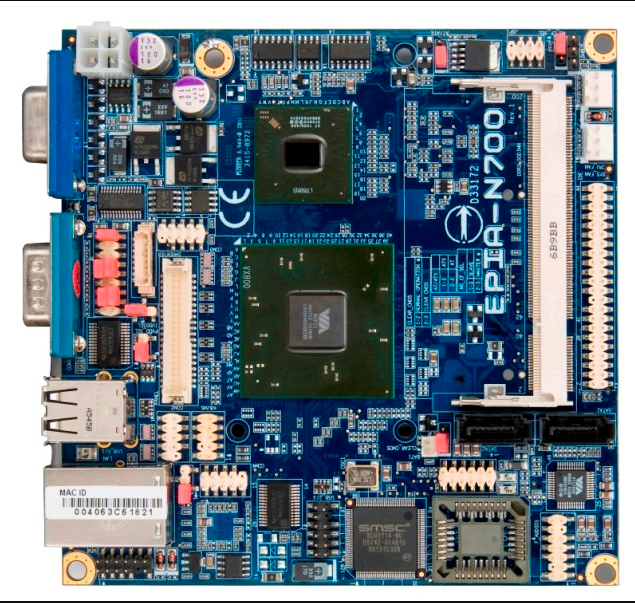
Photo by; VIA Gallery from Hsintien, Taiwan
Ideal for smart digital entertainment devices such as PVR’s, media centers, car PC’s, set-top boxes, and thin devices. Implemented in late 2005, they are fully integrated boards, and have very low power consumption,
- Nano-ITX boards measure at 4.7 x 4.7in (120 x 120mm)
- None. sometimes can include a mini-PCIe expansion slot
- 4 mounting holes.
- Can be used in cases designed for ATX, Micro-ATX, and other ATX variants with appropriate mounting adapters or brackets.
Pico-ITX
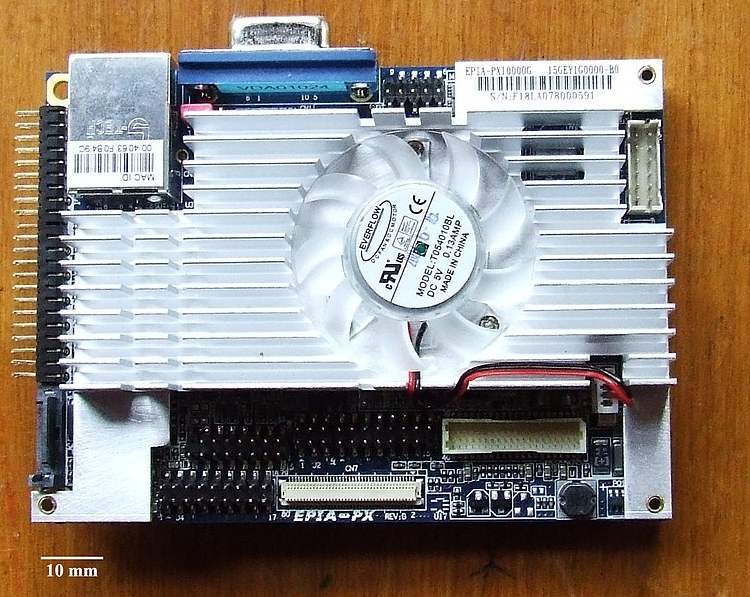
A Pico-ITX board, photo by derivative work: Beta34
Ideal for edge computing, embedded systems, portable or mobile devices, IoT devices, in vehicles computing needs.
- Pico-ITX boards measure at 3.9 x 2.8 inches (100 x 72 mm)
- No expansion slots, due to size constraints. Rarely has mini PCIe
- 4 mounting holes
- Can be used in cases designed for ATX, Micro-ATX, Mini-ITX, and other ATX variants with the right mounting adapters or brackets.
What board for my gaming build?
when choosing a mobo, make sure you it meets these criteria:
- The slot type matches your components
- The number of expansion slots is adequate for your ongoing computing needs
- The dimensions of the motherboard that works with your desktop PC case
Are you going with Intel or AMD? Intel typically has high performance, especially when it comes to applications like gaming. AMD is known for multi-thread performance and affordability, As well as being more future-proof with upgrades later on. Pick the correct socket or slot for the CPU you picked.
What sort of case will you be buying? Often with gaming builds aesthetics are a big deal, you want a PC that will look good on your desk. Find a case that supports ATX, these bigger cases are backwards compatible as well.
Most cases for gaming will come in a ATX size. Unless you are going for a small form factor build, ATX is what you should get. It more readily available in the market as well.
Next look for the kind of RAM you will be buying an ensure your motherboard will support it.
DIMM slots: look for boards that are at least DDR4, or 5. DDR5 is double the speed or DDR4.
If you are someone that requires a lot of memory then DDR5 will get you all the memory you could want, up to 512gb of RAM. If your budget allows it, you should get DDR5, eventually DDR4 will be replaced by DDR5 anyway.
Next you will look for what PCIe slot to buy. PCIe is short for “peripheral component interconnect express”. Each PCIe slot on a motherboard can vary in size and speed, by the number of lanes (x1, x4, x8, 16) and the generation of the interface (3.0, 4.0, 5.0)
Each generation doubles the bandwidth per lane compared to the predecessor. PCIe 5.0 is common in high-end builds.
PCIe in the interface standard for connecting the high speed components that you will be getting for your build. The GPU, sound card, video capture card, storage and RAID controller cards, all use PCIe.
Always use a PCIe x16 slot for graphics cards to maximize their potential. These slots offer the highest bandwidth, which is necessary for modern GPUs.
For SSDs, especially NVMe types, a PCIe x4 slot is typically sufficient. Other cards like sound cards, network cards, or USB expansion cards may only require a PCIe x1 slot.
PCIe is backward compatible, meaning you can use a PCIe 3.0 card in a PCIe 4.0 slot and vice versa. However, the performance will be limited to the lowest PCIe version and lane size involved in the connection.
The main differences between PCIe 4.0 and PCIe 5.0 pertain to speed, bandwidth, and power.
As technology advances, newer PCIe standards will offer significantly improved performance. Opting for a motherboard with the latest PCIe version within your budget can help extend the viability of your system.
Conclusion
The motherboard you choose lays the foundation for your PC’s performance, expandability, and efficiency. By understanding the different motherboard form factors and their intended applications, you can select the best board for your specific needs, ensuring a balanced, future-proof system that meets both your performance requirements and budget.

